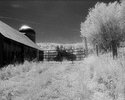Hi Polyglot,
Sorry to hear about the loss of your prints. It must be very frustrating.
Could you take the time to explain your full process? Including how you dried the prints? It might help shed light on the issue.
How long were the prints stored in the boxes for? I use Sistan occasionally and have yet to see any problems like you have experienced. I would like to replicate your process and see if staining occurs.
My process was:
- expose
- 2:00 develop in Multigrade 1+7ish in Jobo at 25C
- 0:30 stop (2% acetic) in Jobo at 25C
- 1:00 fix in 1+4 Rapid Fixer, Jobo at 25C
- 4:00 wash, Jobo at 25C, 6 changes of water
- quick splash of water on both sides of print under a tap (I don't trust the smooth Jobo drums to wash the back of the print well)
- slap print on bathroom mirror, wipe excess water off with hand and wait until basically-dry (back still damp)
- lay print flat on a cloth overnight to become totally dry
- pin to wall and/or put in archive box for between 0.25 and 5 years (no visible degradation, prints look great unless framed)
- treat in Sistan for about 2:00 at 1+20 dilution, room temp in a big plastic bucket outdoors
- wipe excess Sistan off with hands
- dry in the shade (no visible ill effects at this point)
- put in archive box for 2mo
- panic!
There seems to be no correlation between damage to the prints and age of the print in storage, nor the brand of paper (I have Foma, Kentmere, Ilford and Adox).
Ralph: as per my previous post, I think the problem is with insufficient squeegeeing of the Sistan because the shape of the damage seems to correlate with the shapes that drops or dribbles of Sistan would have taken after I wiped the prints off. It does concern me though that Sistan-as-absorbed-by-gelatin is OK/beneficial but a dribble on top of that is destructive.







